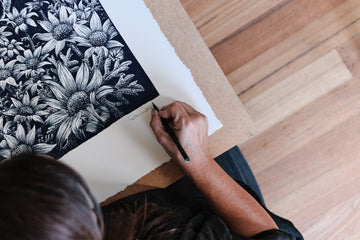"All of my work begins with photography of landscapes, flora and fauna I’ve explored or visited. These images act as references for my drawings, but the drawings themselves are not direct copies, they are reimagined landscapes, emotional responses to place."
Get to know artist Peta West...
Q: Tell us about your background. How long have you been making art?
I come from a traditional photography background that began in the late 1990s. In those early years, I worked with Hasselblads, studio lighting, and the lost art of black-and-white printing in the darkroom. That world taught me discipline, patience, and how to pay attention to light, composition, and detail.
I worked professionally as a photographer for more than two decades, long enough to witness the shift from film to digital and to adapt to the changing industry.
Q: Describe your studio for us.
I live and work in Lake Conjola on the south coast of NSW, a place situated on the lake and surrounded by national park. My studio is a small space we built in the backyard.
When I first began making art it was perfectly suited to my needs, but with the arrival of my first large press, new drying racks and a large working workbench, it’s fair to say I’ve outgrown it. Still, it works — and I love that it allows me to create while being at home with my three kids and our dog.
Q: You worked as a photographer for over two decades prior to becoming a
printmaker. What caused the change for you and how do you think the photography
influences your approach to printmaking?
With the arrival of digital, photography became fast paced and the craft I had grown up with began to change. My love for it shifted too, it no longer carried the same slow rhythm or hands-on techniques that first excited me.
What has always stayed with me, though, is a love of composition: foreground, middle ground and background, the way light falls across a space, and how depth can make an image feel immersive. Framing a landscape through a smaller viewfinder taught me to balance light and shadow, and that sensitivity still shapes my work today.
I rarely stray far from a monochromatic palette, a direct echo of my long relationship with black & white photography.
Q: Could you describe the process of creating your prints?
All of my work begins with photography of landscapes, flora and fauna I’ve explored or visited. These images act as references for my drawings, but the drawings themselves are not direct copies, they are reimagined landscapes, emotional responses to place.
I usually draw directly onto the lino in a loose, gestural way, refining the image as I carve. This approach brings a spontaneity that I wouldn’t achieve if I drew everything on paper first and transferred it across.
Once carving begins, depending on the scale, a single work can take anywhere from 60 to 230 hours to complete. When the carving is finished, I run a series of test prints, refining areas until I’m satisfied with how the image translates to paper. Only then do I print and edition the final work.
Q: Your depictions of the Australian bush are filled with intricate detail and a vivid
sense of abundance. What inspires you to capture the landscape with such richness
and sublimity?
I love detail...I love trying to translate form and texture into marks, finding ways to make marks that looks like a flower with shape and form, with light and shadow is so interesting and challenging for me. Making objects feel 3D within lino prints is part of my thoughts when craving the lino.
I like to create work that gives you a feeling of being immersed in the landscape, giving the work life.

















